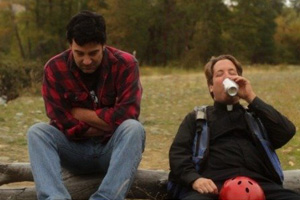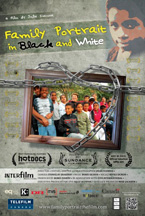SUNDANCE 2011… “INDIE IS BACK”!??
Every pundit is saying it, from the corporate culture flunkies on Entertainment Tonight to our most reasoned long time key players: Sundance 2011 marks the resurgence of “indie film.” I disagree with that statement, although on mostly semantic terms: Indie film, as defined by the bubble years between Sex, Lies, and Videotape/Clerks and Hamlet 2 is NOT back, and that is why Sundance this year was a glorious happening. It is important to clarify and explore what this Sundance actually means for ‘Truly Free Film.’
First off, what is great about Sundance 2011 is not only the selection of unusual, formally inventive films, but the near total absence of corporate engineered, market driven, faux indie high-budget QUIRK CRAP (although there were some more offbeat versions of the old style quirk like My Idiot Brother and Terri, there was not an Answer Man or Sunshine Cleaning in the bunch). Let the studios make the ‘smart” bromances of Seth Rogen and Adam Sandler; when I think of Indie Cinema I want to experience true alternative visions or humor that has not yet been commodified by the crafty advertisement aesthetics of the Spike Jones types. The comedy The Cataclysm Catachism took me there this year.
This was also the first year that Sundance finally made a break with Naturalism. Though there were still plenty of naturalistic entries like On The Ice—an urban drama set in an isolated Alaskan village—or The Off Hours or The Lie, for the first time we saw films that used various authorial voices which managed to tell their stories in a way that implied an oppositional or contradictory attitude towards their characters. For the first time, precious films like The Off Hours were the exception rather than the rule.
The second great thing was that many of this year’s original films, made for a tiny budget, sold for not an insane, stupidly high price, but for a reasonable Mg that gave the filmmakers (those that had back end deals) healthy profit and should also bring the distributors a profit on the back end. The only purchase that seemed a bit reckless was for Another Earth, a film whose popularity somewhat baffled me due to my sense of the film being quite hangdog in mood, acting, plotting and theme. Its rumored budget was $150,000 and I’ve heard several different purchase prices ranging from $750,000 to $2 million to $4 million for world rights. I wonder if their crew, which probably worked for pennies, had any back end participation points, because even at $2m there was some serious profit there for those who managed to leverage their cheap labor against a potential big sale. At these types of low budgets in relation to these purchase prices, I think we all need to start to look again at the labor equation. Maybe it’s time to once again revisit the old InDigEnt model.
The other part of the health equation has yet to actualize: these films need to recoup with viewers in order for this event to turn into a new era. Considering the fees paid in relation to the actual films, I think most of the films stand good chances of recouping via the new distro paths. For example, I think Like Crazy, a well made, sincere, romance will recoup theatrically and then go onto big profits in VOD. Some films I think will bomb theatrically, but due to their cast and plot description, will recoup in VOD.
Another great aspect of the modest acquisition fees (compared with those in the stupid bubble era) is that though the profit margin was high due to the low production budgets, this equation should not be getting corporate minded flim-flam faux indie producers excited. If there is a business model to be extracted from this year’s Sundance, it is this: Make it for under a million, make it personal, make real drama and try to break the standard naturalistic boring old formal mode. That is not a formula that should excite the old hack indie financiers and producers.
Looking way off into the future, I think we will be able to look back on the years between Clerks and Hamlet 2 as indie film’s darkest era. Those were the days, due to high theatrical profit of a small handful of films, market-minded flunkies rushed into the personal cinema space and corrupted its aesthetic values, unleashing year after year of twee faux indie garbage which forced the drama-starved audiences to leave the indie theatrical space and forced them to find their drama fix in long form cable television shows. Sundance in the ‘heyday” years was the handmaiden to the profit motivated Corporate aesthetic. Sundance 2011 is the demarcation of the death of profit-mad Indie and the new era of Truly Free Film. Although Sundance was founded under principals of resistance and the creation of an alternative to the market driven establishment, in reality it helped lead the commodification of Personal cinemas’ aesthetic values by letting itself be the Petri dish that hatched the Indie Film Bubble. Consequently, I don’t think it’s ironic that one of the filmmakers of the profit driven indie generation, Kevin Smith, was one of the few filmmakers who failed to sell his film in this Sundance.
Sundance 2011 was a success not because new distribution models were created or the feature form was reinvented via cell phones, it was successful for the reasons that I predicted in my Filmmaker Magazine article last year. The profit driven faux producers and filmmakers left the room when the market collapsed and what was left were producers and filmmakers who made films for the right reasons. Truly Free Films’ first pioneers John Cassavettes, Ida Lupino, Kenneth Anger and Oscar Micheaux made films because they had something unique and personal to say and they could care less if they had to use new formal styles to get it across. Despite the lack of crowd-sourced demand for their visions, they found a way to make their films. It is those intentions that resulted in the emergence this year of an Ida Lupino like acting/writing/producing personality in Brit Marling, the manic Cassavettes-like mondo energy of Evan Glodell’s Bellflower, and the mythic, repressed, violent angst-fueled Kenneth Anger-esque mystery of Septien. Great personal films were made, as I predicted, for the right reasons and at the right super-low budgets. But the second and third parts of the equation also happened this year.
Second, Sundance actually accepted these formally inventive, outside the system films. There is no way in the Gilmore years films like Bellflower, Septien, and Catechism would have been accepted. These inclusions reflect the freedom of younger programmers at Sundance to get films from left field into the festival. The other reasons why so many offbeat films were programmed was because there was less corporate engineered high-budget crap forced on the programmers than in past years. This was most obviously due to the fact that there were very few actual mini-major films produced in 2010. Also, perhaps, Sundance felt SXSW snapping at its heels, so it went out of its way this year to once again try and be relevant, and part of that strategy was deliberately going after SXSW darlings like Todd Rohal, Michael Tully, Joe Swanberg and Barry Jenkins (as a shorts judge).
The third part of the equation was that solid serious personal dramas were bought, at a healthy price. The distributors I think now recognize that due to Hollywood’s inability or reluctance to create low-budget drama, Indie has found its niche. The Oscar nominations confirm this once again with Sundance films being nominated in not one but several prominent categories.
The fourth part of the equation—the box office performance of these films—has yet to be determined. They need to recoup so that this year becomes not an anomaly but a new state of being. Let’s hope they return the distributors’ costs and turn a decent profit; not a crazy profit, but enough to keep them in business. What we don’t want is pure profit-minded producers flocking back into our space. The stench of their fiscally driven priorities has barely left the theater seats of Sundance from the ‘glory years.’ Let’s hope they are less bullish on Indie than the rest of us and decide that rather than finance or make a crap faux indie film they will stay in Real Estate or banking another year and watch this exciting indie resurgence from the sidelines.
— Mike S. Ryan













aljean
As the producer of two films that count in relation to your smart and true map of indie cred (Cheryl Dunye’s, “The Watermelon Woman,” 1995, $100 K, and one of the last films to get an NEH grant and be debated on the house floor because of it, and Cheryl Dunye’s, “The Owls,” 2010, $21K, made by a collective, distributed by the Film Collaborative, recouped costs this January through festival showings and international sales at a few thousand a pop, and coming to home video in March with First Run Features), I think your discussion of indie history, from Clerks to Hamlet 2 is dead on. The two indie films I have produced are as wildly innovative as the stories we try to tell: of black queer community, questions of self-representation and truth (and fiction and documentary), and cinema’s labored history in relation to the experiences of misunderstood others. We have had an audience for both (thank god for the international queer film circuit: the one arm of indie cinema still truly viable in the sense of community, avid and hungry film lovers, and a supportive infrastructure). Gods speed to QUIRK CRAP and the TWEE INDIE (why the doc was the only thing to see at Sundance for so many years past). One cautionary note, however. Our tiny film did as well as it did because of Dunye’s name (and those of many of our cast, as well, starlets with their own fans). She and we built a history, and a different kind of cred, through our years within the new queer cinema, and I’m not sure how our “success” with “The Owls” would play out for people who have to sell their $21K film with just the film to show.
Pingback: SUNDANCE 2011: Tully’s Wrap-Up – Hammer to Nail